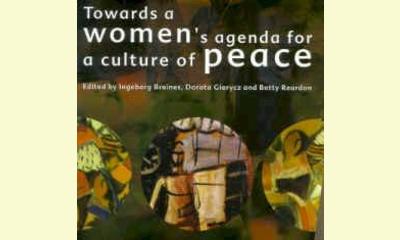|
|
Gender Perspective on a Culture of Peace: A Book Review
an article by Marta Ramón Pascual. Journalist. Barcelona.
Breines, Ingeborg. Towards a Women's Agenda for a Culture of Peace. Paris. UNESCO. 1999. 
click on photo to enlarge
This manual sets out specific initiatives concerning the participation of women in peace, women criticism to the rules of peace, etc.. The second chapter of the first part, entitled 'Engendering's Gender Perspective on a Culture of Peace', tries to explain that only if men and women work together equally in rights we will overcome the obstacles that prevent us from building a vision of future.
The author is Ingeborg Breines, Director of UNESCO's program "Women and the Culture of Peace”. This chapter relies on the interdisciplinary project of the same Organization, "Towards a Culture of Peace" (1998), based on the principles described in the Charter of the United Nations. UNESCO believes that peace must be sustained by democratic participation, good governance and creativity. Education in all its forms is understood as the key to democracy in daily life. According to Federico Mayor Zaragoza, the "culture of peace consists in moving from the logic of force and fear to the force of reason and love”.
The X point of the Letter of Peace addressed to the UN says "Democracy must take a qualitative leap in order to defend and favour every person's opportunity to live in keeping with his or her conscience without ever, of course, curtailing anyone else´s freedom, or causing damage to others or to oneself". But what does this mean, which aspects have to be changed? Furthermore, the point IX suggests: "it is clear that it is impossible to build worldwide peace while in society itself, and even in the family, there is disdain towards more than half of its members: (children, senior citizens, marginalized groups and, of course, women). Rather, a full recognition and respect for their dignity and their rights would lead towards favouring peace". In sum, Breines´s book and the Letter of Peace addressed to the UN agree completly that equality, development and peace are inextricably linked: there can be no lasting peace without development, or sustainable development without full equality between men and women.
(Editor's note: This review was posted April 27, 2011 on the website of The Letter of Peace Addressed to the UN.
|








|
DISCUSSION
Question(s) related to this article:
What are the most important books about the culture of peace?,
* * * * *
Latest reader comment:
Johan Galtung is indeed the most perceptive peace researcher of our time.
Not only did he predict the fall of the Soviet Union quite precisely, but he has also predicted the fall of the American empire. Here are excerpts from his 2004 article,
On the Coming Decline and Fall of the US Empire
The prediction of the decline and fall of the US Empire is based on the synergy of 14 contradictions, and the time span for the contradictions to work their way through decline to fall was estimated at 25 years in the year 2000. There are more contradictions because the US Empire is more complex, and the time span is longer also because it is more sophisticated. After the first months of President George W. Bush (selected) the time span was reduced to 20 years because of the way in which he sharpened so many of the contradictions posited the year before, and because his extreme singlemindedness made him blind to the negative, complex synergies. . . .
Here is the list of 14 contradictions posited in 2000:
I. Economic Contradictions(US led system WB/IMF/WTO NYSE Pentagon)
1. between growth and distribution: overproduction relative to demand, 1.4 billion below $ 1/day, 100.000 die/day, 1/4 of hunger
2. between productive and finance economy (currency, stocks,bonds) overvalued, hence crashes, unemployment, contract work
3. between production/distribution/consumption and nature: ecocrisis, depletion/pollution, global warming
II. Military Contradictions (US led system NATO/TIAP/USA-Japan)
4. between US state terrorism and terrorism: Blowback
5. between US and allies (except UK, D, Japan), saying enough
6. between US hegemony in Eurasia and the Russia India China triangle, with 40% of humanity
7. between US led NATO and EU army: The Tindemans follow-up
III. Political Contradictions (US exceptionalism under God)
8. between USA and the UN: The UN hitting back
9. between USA and the EU: vying for Orthodox/Muslim support
IV. Cultural Contradictions (US triumphant plebeian culture)
10. between US Judeo-Christianity and Islam (25% of humanity; UNSC nucleus has four Christian and none of the 56 Muslim countries).
11. between US and the oldest civilizations (Chinese, Indian, Mesopotamian, Aztec/Inca/Maya)
12. between US and European elite culture: France, Germany, etc.
V. Social Contradictions (US led world elites vs the rest: World Economic Forum, Davos vs World Social Forum, Porto Alegre)
13. between state corporate elites and working classes of unemployed and contract workers. The middle classes?
14. between older generation and youth: Seattle, Washington, Praha, Genova and ever younger youth. The middle generation?
15. To this could be added: between myth and reality.

|
|









